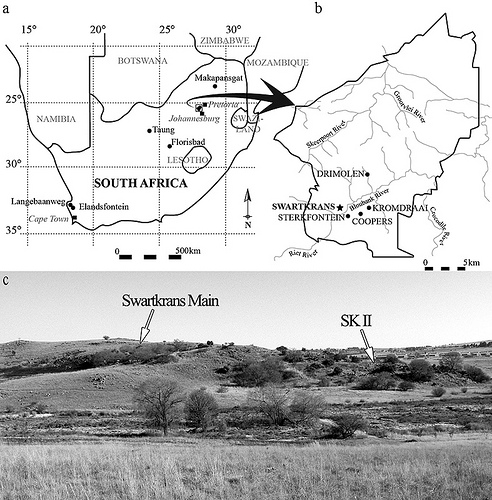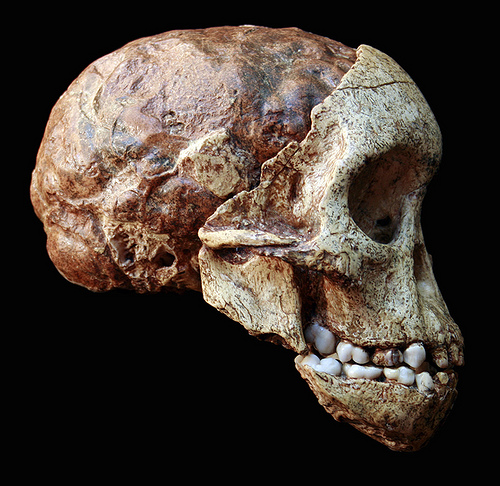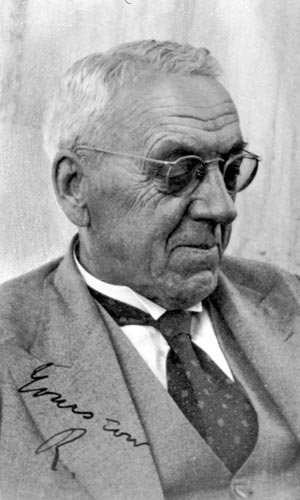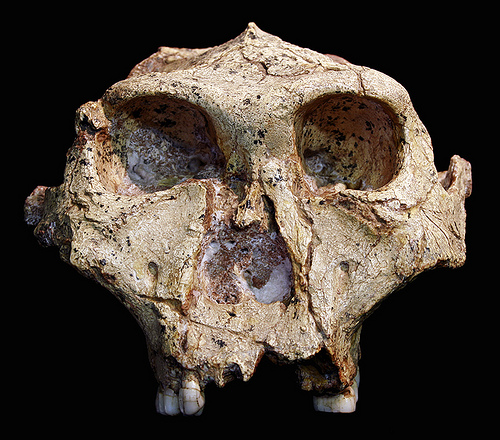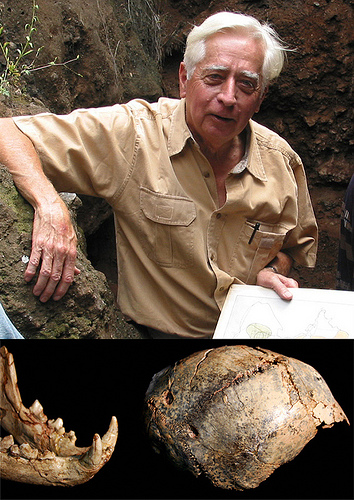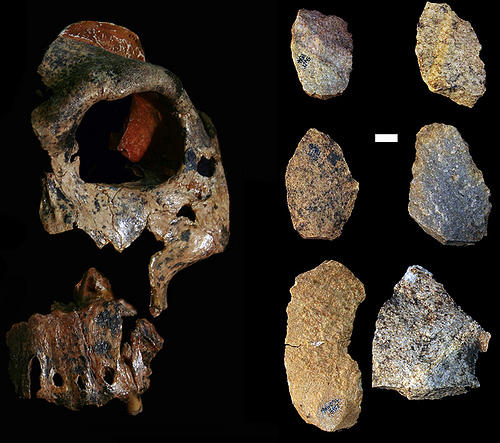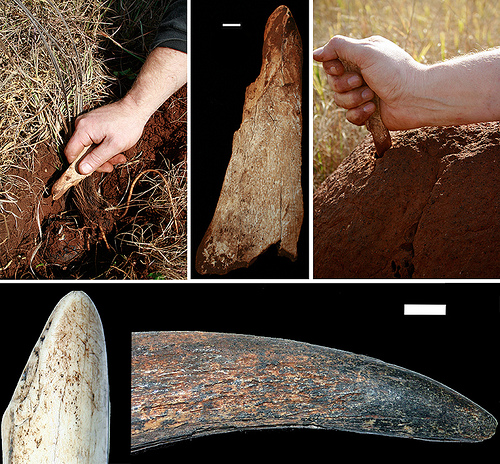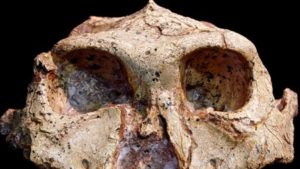
We who study human evolution in South Africa are fortunate to work in a time of great excitement. It’s not every day that our research finds its way into the headlines. But, discoveries of early human skeletons were recently splashed across the pages of the New York Times. They spoke of the “Cradle of Humankind,” a 466 square km UNESCO World Heritage site comprising dozens of caves in populous Gauteng Province, which is home to the metropolises of Johannesburg and Pretoria. Not long ago the Sterkfontein and Malapa caves gave up, respectively, “Little Foot,” about 3.5 million years old, and “Karabo,” about 2 million years old. And now, we have Homo naledi, found in the Rising Star cave system.
We join our paleoanthropological colleagues and the interested public in applauding these thrilling and edifying discoveries. But we also welcome the opportunity this publicity affords to dust off another jewel in South Africa’s fossil crown—the cave of Swartkrans. This is a site every bit as unassuming, and just as fundamentally significant to studies of human evolution, as is its long-time director of research, C. K. (Bob) Brain.
__________________________________________________________________________________________
Above: Top section, Swartkrans Cave’s position (star) in the “Cradle of Humankind,” with some other important human evolution sites indicated by black dots (top right). Bottom section, view of Swartkrans looking north, across the Bloubank River (bottom); SK II is a fossil-rich side-extension of the site’s main cave, in which we have initiated exploratory research.
____________________________________________________________
The pioneers
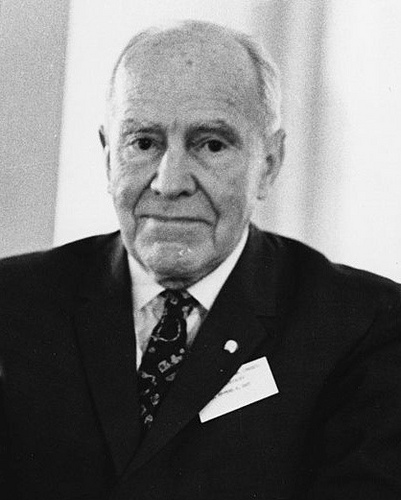 Brain’s path to Swartkrans was paved by Robert Broom, one of the most important paleoanthropologists of the twentieth century. After many years prospecting for fossils of the reptilian ancestors of mammals in the tough backcountries of Australia and South Africa, Broom became intrigued by the 1925 publication of the skull of an early human toddler, the “Taung Child” (nicknamed for the cave where it was found). Raymond Dart (pictured right*), who described the skull, argued that it represented a previously unknown ancestral species of human, that lived millions of years ago, soon after the chimpanzee and human lineages split apart from a common ancestor. Dart called the new human species Australopithecus africanus.
Brain’s path to Swartkrans was paved by Robert Broom, one of the most important paleoanthropologists of the twentieth century. After many years prospecting for fossils of the reptilian ancestors of mammals in the tough backcountries of Australia and South Africa, Broom became intrigued by the 1925 publication of the skull of an early human toddler, the “Taung Child” (nicknamed for the cave where it was found). Raymond Dart (pictured right*), who described the skull, argued that it represented a previously unknown ancestral species of human, that lived millions of years ago, soon after the chimpanzee and human lineages split apart from a common ancestor. Dart called the new human species Australopithecus africanus.
________________________________________________________________
The Taung Child, Australopithecus africanus skull. Credit Jason L. Heaton
_________________________________________________________________________________________
In the ensuing decades, several other species of Australopithecus (or, in the vernacular, “ape-men”) have been identified across Africa, from geological contexts ranging between 4.2 and less than a million years ago. But throughout the 1920s, ‘30s and ‘40s, Australopithecus, with its small braincase and ape-like face, found little acceptance in the halls of European and American academies. Most experts consigned the Taung Child to the non-human ape category, and granted it no special significance for elucidating human evolution. Everyone “knew” Africa was a dead end for paleoanthropological research; Europe was the birthplace of humanity. That had been the thinking since 1912, when the “Piltdown Man” skull was unearthed in England. Piltdown Man was “obviously” a transitional, ape-like species, with a primitive lower jaw and teeth, but a large, advanced human-like braincase. Such was the view of the most respected early twentieth century scientific experts. Piltdown Man was, of course, eventually proven to be a hoax—the cranium of a modern human and the lower jawbone of an orangutan, clumsily altered to look timeworn, and then planted together in the Piltdown gravel pit. But its initial universal acceptance as a human ancestor forestalled appreciation of the evidence of human evolution in South Africa for nearly forty years.
Robert Broom’s belief in the Taung Child was an important exception to the prevailing attitude. In fact, after meeting Dart and seeing the Taung Child firsthand, Broom’s stated mission became finding more examples of this fossil’s kind, which he was convinced would persuade the rest the world that Australopithecus was a bona fide human ancestor. Broom (pictured left**) had success on both fronts, recovering Australopithecus fossils at Sterkfontein Cave in the 1930s and then, in 1948, shifting his attention to Swartkrans Cave, less than a kilometer north of Sterkfontein, across the underwhelming Bloubank River.
With assistance from paleontologist John Robinson, Broom’s work at Swartkrans soon yielded abundant Australopithecus fossils. However, the skulls of the Swartkrans fossil humans are more heavily built, and their teeth more thickly enameled than those of Australopithecus africanus. Broom had found similar, robustly built ape-man fossils in 1938 at nearby Kromdraai Cave. Broom and Robinson were convinced that the differences between Australopithecus africanus and the Swartkrans/Kromdraai fossils were so significant that the two types warranted separate status, and argued that the latter fossils represented a more specialized form of ape-man, belonging to a genus they named Paranthropus.
__________________________________________________________________________________________
SK 48, a Paranthropus robustus cranium from Swartkrans. Credit Jason L. Heaton
__________________________________________________________________________________________
Present-day specialists disagree as to whether or not Paranthropus is so different from Australopithecus as to merit its own separate classification. We won’t concern ourselves with that issue here, but we do stress that more recent work at Swartkrans has gone a long way toward clarifying the ecology and behavioral adaptations of the “robust” ape-men, as compared to the older and more fine-boned Australopithecus africanus from Taung and Sterkfontein caves.
It must be said that the original efforts toward a better understanding of ecology and behavior were largely John Robinson’s, who, by the 1950s had formulated what became known as the “dietary hypothesis” to explain the perceived differences between Paranthropus and Australopithecus. At that time, many believed (erroneously) that Australopithecus africanus was the direct ancestor of our genus, Homo, and (also erroneously) that Australopithecus africanus was contemporary with Paranthropus from Swartkrans.
Robinson, and others, understood that the habitats of all the ape-man species were less forested than those of the creatures of previous times from which they evolved. Just as in Africa today, plant foods preferred by hominins—things like soft, ripe fruits and tender, young leaves—were much less abundant in savannas than in forests. Robinson conjectured that savanna-dwelling Paranthropus maintained a strictly herbivorous diet, but diverged from its forest ancestors in specializing on the coarse vegetable matter common in open country. Such resources, like nuts and plant roots, are either extremely hard or fibrous—tough to chew—and it was in this light that the large jaws and thickly enameled teeth of Paranthropus made evolutionary sense.
In contrast, the jaws and teeth of Homo, and its presumptive ancestor, Australopithecus africanus, are more gracile. Robinson contended that this more lightly constructed ape-man (and, later, Homo) “solved” the problem of savanna survival by incorporating meat into its diet. Meat on the hoof—in the form of large herds of grazing ungulates—is more readily available on the African savanna than it is in its forests. Meat is also relatively soft and does not require that its consumer have a massive dental apparatus in order to break it down in the mouth. Meat does, however, adhere to bones, comes in large packages, and is stubbornly encased in hairy, elastic hides, so a cutting technology would have been most useful for a clawless and blunt-toothed human ancestor that had begun to exploit this resource. Thus, the invention of stone tools—at ~2.5-million-years-ago, roughly coincident with the emergence of the robust ape-men and the genus Homo—became completely explicable and assignable to proto-Homo with the resource partitioning between gracile- and robust-jawed human forms envisaged in Robinson’s dietary hypothesis. Further, acquiring meat presumably requires a smarter brain than does picking stationary nuts or grubbing for fixed roots. Under this construct, it was therefore not surprising that our large-brained, small-faced lineage persists today as us, and that the small-brained, large-faced robust ape-man Paranthropus eventually went extinct.
A new protagonist for a new age
This narrative was firmly ensconced in paleoanthropology by the mid-1960s, when a new generation of research was begun at Swartkrans by Bob Brain. Like Broom, Brain’s career in paleoanthropology was heavily influenced by Raymond Dart. But, unlike Broom, Brain was more concerned with Dart’s ideas about the behavior of early humans, than with his interpretations of their anatomy and classification. Dart argued that ape-men were “confirmed killers: carnivorous creatures, that seized living quarries by violence, battered them to death, tore apart their broken bodies, dismembered them limb from limb, slaking their ravenous thirst with the hot blood of victims and greedily devouring livid writhing flesh.” According to Dart, ape-men were able to enact all this mayhem by wielding the defleshed bones of their prey as weapons against their next victims. Given Dart’s considerable influence among his peers, human ancestors were now conceived of as “killer apes,” no less bloodthirsty than a fictional band of post-apocalyptic, flesh-eating zombies.
Brain was, in response to Dart’s killer ape scenario, agog. The hypothesis cried out to be tested, and Swartkrans Cave became Brain’s primary proving ground. Importantly, Brain brought to this fossil laboratory his knowledge of cause-and-effect relationships in the modern world as they related to the accumulation of bones in caves. Brain’s research on bone-accumulating processes in caves revealed that the patterns of animal body part representation and bone damage documented by Dart at ape-man sites were comfortably attributable to forces other than the supposed predatory and murderous behavior of cave-dwelling ape-men. Portions of antelope bones represented at Swartkrans were not there because they were selected by ape-men to use as tools and weapons. Rather, they were simply those skeletal parts that were too dense or too poor in nutrients for carnivores to destroy when consuming the carcasses that they had dragged into the cave.
With modern caves in mind, ancient Swartkrans could no longer be reconstructed as the dank domicile of ape-men. Instead, Brain revealed the cave to be the receptacle of feeding debris that was generated over long periods by large cats and hyenas. And, based on the great number of their fossils, including many scarred by carnivore tooth marks, ape-men were apparently one of the favorite prey animals of those predators. Dents and missing sections of Paranthropus skulls were not created by bone clubs, as Dart had contended, but instead by accumulated pressure, as bones were being buried and compressed under the increasing weight of sediment that washed into the cave year after year. The reason that skulls of ape-men are so abundant at Swartkrans is that heads offered little in the way of nutritional value to carnivores; the rest of the ape-man body, a comparative wealth of meat and marrow, was consumed in its near-entirety. In the process, bones were crushed into unidentifiable splinters. As Brain continued to develop these thoroughly convincing, but comparatively mundane, rejoinders to Dart’s fantastic scenarios of how ape-man sites formed, the killer ape hypothesis was dismantled.
__________________________________________________________________________________________
Long-time director of research at Swartkrans, C.K. (Bob) Brain (top). SK 54, a Paranthropus robustus cranium from Swartkrans (bottom right) with two puncture marks, created by the lower canine teeth of its presumed predator, a leopard—the lower jaw of which is illustrated on the bottom left. Credit Jason L. Heaton
_________________________________________________________________________________________
Brain’s real-world results pulled back the veil to reveal ape-men not as cannibalistic hunters, but as hapless prey. His conclusions also accorded well with Robinson’s view that Paranthropus was a herbivore, eking out an existence in the long shadows thrown by a raft of menacing carnivores. Moreover, Brain’s new archaeological investigations at Swartkrans only solidified the notion that its fossil denizens were much meeker “noble savages” than envisaged by Dart. That Swartkrans yielded stone cutting tools came as no surprise. It was way back in 1949, still under the aegis of Broom and Robinson, that the first fossil of the genus Homo was discovered at Swartkrans (originally classified as Telanthropus, but quickly subsumed into our own—the “true” human—genus). Following Robinson’s dietary hypothesis, Homo was naturally linked to stone tools because, as an omnivore, Homo “obviously” required a cutting technology in order to render animal carcasses into edible portions.
__________________________________________________________________________________________
SK 847, the cranium of early Homo from Swartkrans (left) with simple stone cutting tools (right), probably used to butcher the carcasses of large prey animals. Credit Jason L. Heaton
_________________________________________________________________________________________
More unexpected at Swartkrans was Brain’s unearthing of a cache of pointed antelope long-bone fragments, delicately smoothed and polished at their ends—completely unlike the mass of other unintentionally broken bones also found in the cave.
But make no mistake. Brain’s bone points are not some dubious echo of Dart’s fanciful ape-man bone-tool culture, but are instead genuine implements made and used by ancient humans. When Brain showed the nearly blind, 90-year-old Dart the new tools in 1981, Dart felt the smooth, tapering points with his fingers. Then he said:
“Brain, I always told you that [ape-men] made bone tools, but you never believed me! What were these used for?” I [Brain] replied that I thought that they had been used for digging in the ground [in order to extract edible roots]. Dart slumped back in his chair with a look of total disbelief on his face. “That,” he said, “is the most unromantic explanation I have heard of in my life!” He then grabbed the longest of the bone points and stuck it into my ribs saying, “Brain, I could run you through with this!”
Never mind Dart’s good-natured protestations: paleoanthropologists quickly accepted Brain’s more pedestrian interpretation that Paranthropus, the specialized herbivore, used the bone tools to dig up plant roots to eat.
__________________________________________________________________________________________
Replicas of bone tools from Swartkrans used for digging up an edible plant root (top left) and to breech a termite mound (top right); wear on a utilized tool is shown in the middle top panel. Actual fossil bone tools from Swartkrans (bottom). Credit Jason L. Heaton
__________________________________________________________________________________________
By 1979, Brain’s other major archaeological discovery at Swartkrans—nearly 300 burned bones—had come to light. Unlike the case of the bone tools, specialists tended to credit these traces to the activities of Homo, and not to Paranthropus. This is because Brain’s analyses concluded that the bones were burned in humanly controlled fires, which are among the earliest known in the world. For many, this major technological innovation was beyond the ability (and need) of the small-brained, herbivorous ape-men. In contrast, larger-brained, meat-eating Homo was presumed smart enough to have harnessed fire and to have also benefited from its use to ward off predators and cook meat and other foods.
On the shoulders of giants
By 1990, Brain had closed down excavations at Swartkrans. But the new decade would see the introduction of a wave of cutting-edge technologies brought to bear on paleoanthropological questions. One of the biggest advances came in the study of the chemistry of human tooth enamel, which showed that, contrary to expectations, Paranthropus robustus actually had a varied diet, not restricted to the types of foods predicted by the dietary hypothesis. Different types of plants utilize different varieties, or isotopes, of carbon during photosynthesis, creating distinct isotopic signatures in their tissues. These unique signatures are transferred through the food chain to consumers of those plants and to consumers of the plant-eaters and so forth. Bottom-line: the rugged construction of the Paranthropus robustus skull and teeth, built to devour tough, low-quality foods, belies its actually very eclectic diet. Most specialists now believe that the ape-man’s extreme anatomy is not a reflection of its day-to-day diet, but was an adaptation for consuming less-desired foods when better, higher-quality ones were unobtainable—a good thing indeed, but one that was not readily apparent when scientists were restricted to hypothesizing about subsistence based solely on anatomy.
So, here we find ourselves as the stewards of Swartkrans Cave since 2006—overseeing research at a site that has produced an embarrassment of paleoanthropological riches, from bone and stone tools, to some of the earliest evidence of humanly controlled fire in the world, to the oldest humanly butchered bones in southern Africa, to hundreds of fossils of two distinct ancient human species. Our current work is focused on exploring new areas of the site and its older deposits; on better understanding the processes that formed the site; and especially on developing a clearer understanding of the interrelationships and ecological separation (and overlap) of Paranthropus robustus and early Homo. The presence of these two contemporary and broadly adapted human species prohibits the simple inferences that characterized earlier studies about the authorship of the site’s abundant and important archaeological traces. Our task is thus exceptionally challenging, but also eminently invigorating and gratifying.
_______________________________
Suggested reading
Brain CK. 1981. The Hunters or the Hunted? An Introduction to African Cave Taphonomy. Chicago: University of Chicago Press.
Brain CK (editor). 2004. Swartkrans: A Cave’s Chronicle of Early Man, 2nd Edition. Pretoria: Transvaal Museum.
Pickering TR, Schick K, Toth N (editors). 2007. Breathing Life into Fossils: Taphonomic Studies in Honor of C.K. (Bob) Brain. Bloomington (IN): Stone Age Institute Press.
Pickering TR and Heaton JL. 2009. Roots, bugs and venison: prehistoric cuisine at Swartkrans Cave. Quest 5: 3-9.
Ungar P, Sponheimer M. 2011. The diets of early hominins. Science 334: 190-193.
_______________________________________________________________________________________________________________________
* Australian-born anatomist and paleoanthropologist Raymond Arthur Dart (1893-1988), a professor and dean at the University of Witwatersrand, Johannesburg, South Africa, 1925-1943, was best known for his 1924 discovery of fossil remains of Australopithecus africanus. Smithsonian Institution Archives, Wikimedia Commons
** Portrait of Robert Broom. Wikimedia Commons

